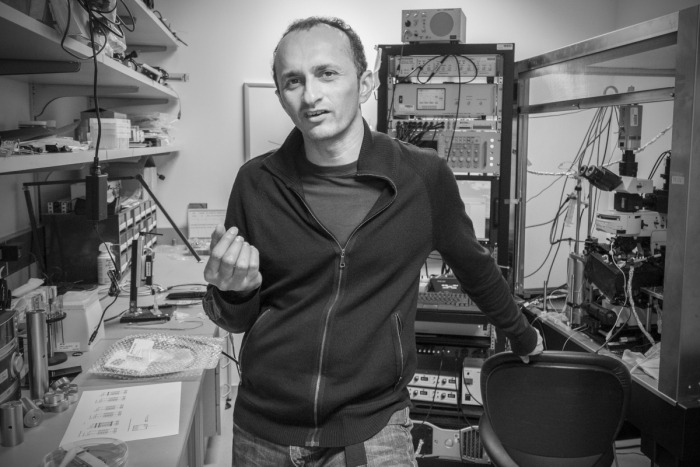In November, Janelia announced a new research focus: Mechanistic Cognitive Neuroscience.
What does that mean? Janelia Senior Group Leader Vivek Jayaraman explains more in this Q&A.
Q: |
What's the big goal for the Mechanistic Cognitive Neuroscience research area? |
A: |
We want to understand how the brain enables cognition. This is perhaps the ultimate question in neuroscience, but it’s been explored more within psychology than neuroscience – and within neuroscience, rarely at the level of neural mechanisms. We’re creating a program in which tool-builders, experimental neurobiologists, and theorists work collaboratively to clear the technical, conceptual, and computational hurdles that have made some of the most intriguing aspects of cognition seem beyond the purview of mechanistic neuroscience. |
Q: |
How would you define cognition? And what do you mean by "mechanistic?" |
A: |
I view cognition as a continuum of mental processes of differing sophistication that enable us to acquire knowledge and use it flexibly at a later time, giving us the ability to go beyond reflexive or innate behaviors. Examples might include processes that allow us to: create mental models of our environment (such as representations of where we are and where we’d like to go); develop expectations and make intelligent decisions with incomplete information; and interact effectively in complex social situations. Cognition has long been studied at the level of behavior and neural dynamics in primates, and this work has generated important models of underlying computational mechanisms. By necessity, most of these models have been at the level of interactions between large brain regions. By “mechanistic” we mean that our goal is to achieve a detailed understanding of how cognitive processes and behavior are implemented at the level of circuits, cells, and molecules. This level of explanation, which requires knowing a lot about the neural substrates involved, has really only been achieved for neural computations that happen in the first few stages of sensory processing or for reflexive movements. And even with all the tools available today, this is perhaps conceivable for only the simplest of innate behaviors. A lot of cognitive processing happens in recurrently connected circuits deep in the brain, and getting a handle on the dynamics of such circuits can be difficult. So getting to implementation-level understanding will be challenging. We think Janelia can help transform this field over the next 15 years. |
Q: |
How will you study cognition? |
A: |
Cognitive processes are typically engaged when animals display rich and complex behaviors that are difficult to quantify and interpret. As a result, modern neuroscience has largely favored interrogating neural circuits in highly trained animals performing tasks that are repeatable and simple enough to facilitate measurement and analysis. But training and practice make tasks easier to perform by rote. So, almost by definition, an over-trained animal is not using its full cognitive capacity. We will develop ways to measure, perturb, and interpret an animal’s neural activity under conditions that elicit complex and rapidly-adapting behavior – for example, inventive lab tasks inspired by a rodent’s flexible actions, reliance on inference from recent experience, reasoning about the behavior of others, and navigational abilities evident as it forages in the woods among competitors and predators. Further, we will identify changes at the molecular and cellular levels that underlie long-term behavioral flexibility. Studying cell biological processes in the brain of a behaving animal is far from trivial – you seldom even know which cells and synapses to interrogate – but we aim to connect behavioral changes to underlying computations and, ultimately, to the building blocks of circuit and cellular plasticity. Theory will play a central role in our exploration of this complex terrain. For certain systems and circuits, theorists should be the ones driving discussions about the experiments that would provide the most insight, rather than coming in late and providing what we half-jokingly refer to as the “Figure 6 model.” We hope to attract the sorts of experimentalists and theorists who would be excited to collaborate from the beginning of a project. |
Q: |
What kinds of model systems will you use to advance this research? |
A: |
We hope to tighten conceptual and technical links across genetic model systems currently studied at Janelia – rodents, flies, and fish – each with their complementary strengths. Fundamental to our quest is the idea that cognition has evolved by using, recombining, and building upon mechanisms present in animals with simpler behavioral repertoires. Work at Janelia and elsewhere has demonstrated that rodents are capable of behavioral complexity previously associated only with primates. In turn, our fly scientists have benefited from the conceptual groundwork laid by mammalian neuroscientists and showed that flies are also “smarter” than previously thought – flies demonstrate learning and navigational behaviors, as well as complex brain dynamics that resemble those found in mammals. The small size of the fly brain, the continuing development of methods for measuring and manipulating genetically defined populations of cells in behaving animals, and the likelihood of obtaining the complete wiring diagram (connectome) of the adult fly brain in just a few years should give us the most rapid route to comprehensive mechanistic insight in any organism. But, we hope it will also yield strategies broadly relevant to understanding the more sophisticated neural and behavioral repertoire of vertebrates. The transparency of zebrafish, particularly in the larval stage, makes it possible to perform whole-brain imaging, which is a very powerful aid to localize computations to specific brain regions, and to suggest novel hypotheses about systemic function that can guide research in other systems. To tackle some of the most advanced cognitive problems, we’ll focus on rodents; we expect that work to expose at least some computational mechanisms that can be studied at the implementation level, both in rodents and in flies. Overall, we expect convergence in neural circuit designs, which will not only generate and constrain hypotheses about brain function across systems, but will also help prioritize further experiments. |
Q: |
Why is Janelia the best place to do this research? |
A: |
The benefit of working on this problem at Janelia is that it plays to our strengths – every aspect of the research has a foundation in collaboration, requires creative approaches to measurement and analysis, and depends on the focused development and refinement of tools and methodology. At Janelia, theorists work closely with experimentalists, who work closely with tool-builders… such connections are organic and happen all the time, sometimes literally going from a casual conversation over lunch or tea to a result in the lab within a few days. What gives us the confidence to set ambitious goals are the aces we have up our sleeve: Project Teams, which generate and distribute field-transforming reagents and data; Janelia Experimental Technology (jET), which designs and builds innovative tools, and our many other Support Teams, which provide core support that allows us to keep our labs lean and focused. And, of course, the Molecular and Imaging Tools labs and the Computation and Theory labs are engines of discovery for all of Janelia’s research areas. The integrative, collaborative, high-risk research that it will take to achieve our goals is exactly what Janelia was built to do. |
Q: |
Janelia recently announced it was moving to a 15-year research cycle. How will this model help advance the goals of the Mechanistic Cognitive Neuroscience research focus? |
A: |
The 15-year model serves the broader purpose of maximizing Janelia’s impact in the long-run. Defining a timeline will ensure that we are always pushing the envelope, rather than settling into more conventional, conservative research. Building on Janelia’s existing program on neural circuits and behavior will give us a running start. We’re pursuing one of the biggest questions in brain science, and knowing that we have 15 years to get as far as we can toward an answer is a great motivator. Fifteen years is time enough to make the fly the benchmark for a detailed understanding of the building blocks of cognition. And our goals on the vertebrate side are no less ambitious – we hope to provide rodent and fish cognitive neuroscience with the sort of boost that Janelia’s first decade delivered to our inaugural area of focus, the broader study of neural circuits and behavior. We’ll look to blaze trails conceptually, technically, and strategically, and the timeline will push us to identify the most effective paths to gaining deep insight. |


